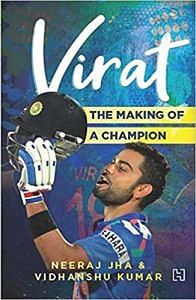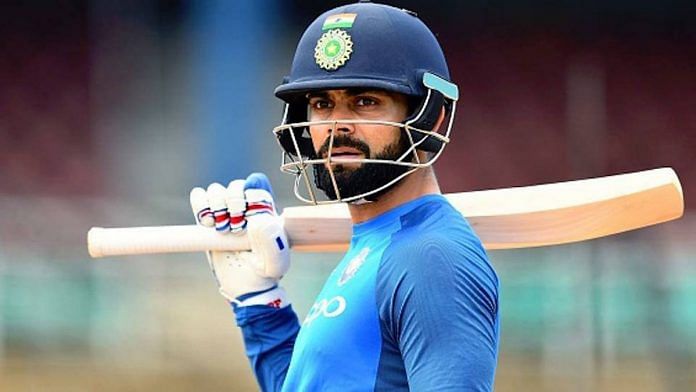It all began in the summer of 1998.
On 30 May, a particularly hot day, a Delhi-based lawyer, Prem Kohli, ferried his two children, Vikas and Virat – both staunch Sachin fans – to a cricket camp in west Delhi.
It was as if Sachin Tendulkar was the answer to all of India’s problems and sorrows, and he was inspiring an entire generation to follow cricket like never before. It was because of Sachin that cricket camps mushroomed across the country. One such training centre, the West Delhi Cricket Academy, was run by coach Rajkumar Sharma and he was witnessing a good turnout of young hopefuls on that hot summer day.
Not just fun and games
Among the 250-odd kids who had lined up to register, one young boy caught the coach’s attention. ‘I remember noticing this pretty chubby, pretty naughty sort of youngster, who was not even ten, registering enthusiastically,’ the coach recalls. ‘He had come with his father and brother.’ It was the younger sibling who was the promising powerhouse.
Still, at his age, mop-haired Virat was among the younger members in the camp and it was certainly not going to be easy for him.
The boy was there to be a batsman, which meant that his days of playing cricket with soft balls in lanes and backyards were over… Coach Sharma had a difficult task at hand – to make a proper, balanced batsman out of an enthusiastic gully cricketer.
Virat had to grow up quickly and grow strong. He had to face bowlers who were quite a few years older – and much taller! – but that didn’t seem to bother him. There was an unshakable self-assurance about him, much beyond his years, that baffled even a seasoned coach like Sharma. ‘After only a month or so I could make out that he was the best in his age group,’ Coach Sharma says. ‘As a player, he looked so good for his age. What stood out was that he was not afraid of anyone and was willing to play the seniors from day one. He was confident and had tremendous self-belief.’
Also read: Sugar and spice, and not so nice: An arrogant Virat Kohli is great news for Indian cricket
It is said that cricket is a game played ‘between the ears’; it is a game where mental strength is a huge factor in the magic mix for victory, and Coach Sharma believed that young Virat was very sure of himself. What Virat needed was someone to help him sharpen the technical aspects of his game.
This was easier said than done.
Wrongs and rights
As a young, right-handed batsman, Virat knew his own mind. He was developing his own unique style in gathering runs. With a strong bottom-handed grip, Virat was mainly an onside player.
The flick off his pads was fast becoming Virat’s mainstay shot. Even when playing offside cover drives, Virat would still trust his bottom hand, which was something that even the best players wouldn’t do. That’s because when one plays with a strong bottom hand, there is a risk of scooping the ball in the air and offering the chance of a catch to the opposition. But Virat was defying all such rules and playing cover drives successfully.
Initially, everything seemed rosy as Virat evolved his own ingenious, if not technically perfect, ways of getting runs. However, in cricket it’s easy to slip up due to a lack of technique. Good bowlers are clever at sussing the batsman out – they quickly weigh up his strengths and weaknesses, and then change their bowling plan into a strategy that exposes the batsman’s shortcomings.
Soon, Virat was facing the same situation. Bowlers were beginning to call him out on his flick shots. So, when he was out leg before wicket (lbw) for the umpteenth time while playing the flick shot from around the middle stump, despite being cautioned against it many times before, Coach Sharma was furious.
Also read: Look at Virat Kohli as a world-beating cricketer, not as your son-in-law
‘It was for playing the flick shot that I scolded him the most,’ Coach Sharma recalls. ‘This was because he used to play the flick early in his innings without pulling his leg towards the leg stump.’ Coaches won’t stop a young batsman from playing a flick shot off the pads, but they are usually not happy when the same flick is played from the middle or off stumps as it carries a risk of taking an edge and getting caught behind the wicket.
Sharma set a regimen for Virat in which he had to resist playing the flick from around his middle stump. Virat too had realized his mistake and was determined not to repeat it and endanger his time at the crease. Day in and day out, month after month, Virat practised until he was able to iron out this weakness.
‘He was getting out lbw a lot in the early days, but he mastered that shot,’ Coach Sharma recounts. ‘He worked really hard on it. Earlier, he was not going forward full length to approach the ball, but slowly that was changing too.’
And soon, a polished player, with fine-tuned shots, began to emerge.
Virat still loved to flick, but he had learnt to be patient, to wait for the right ball. While his naturally strong bottom hand remained, Virat made sure that he was in the correct position to play the shot. With these errors corrected, he soon became unbeatable in his small circle. Virat was already doing things right.
The boy would never miss a practice session. He listened to his coaches and worked hard to amend his mistakes. So much so that in the tournament that he played under Coach Sharma in 2003, five years after he had joined the camp, Virat was simply invincible.
‘The Delhi Development Authority’s Sports Complex ground in Hari Nagar [where the tournament was being played] is not very large,’ says Coach Sharma, ‘but it can still challenge young players. Virat was clearing the ropes regularly with – fours or sixes – and also hitting delectable shots in all directions. It was a sheer delight to watch. I was so happy that Virat had put right his mistake and was ready to take on any challenge.’
Indeed, he was. In that tournament of six games – which included three league games and a quarter-final, a semi- final and the final – Virat was out only once! Of course, he was also the highest scorer, playing beautiful shots all around the ground. This was a big personal victory for Virat. He had made his first tracks towards perfection. With hard work and discipline, he had turned his weaknesses into strengths – the sign of a future champion.
‘Smell the leather’ – that’s what the coaching manual says about playing a forward- defensive block – stretch out your front foot, meet the ball under the eye, so close that you could actually sniff it. This shot was a winning one in the arsenal of cricket legends like Sunil Gavaskar and Mohinder Amarnath, but when a fourteen-year-old displayed skills way beyond his age while playing this stroke, he was sure to catch the attention of the people watching closely. And it was not only the defensive blocks, but also the many shots he played around the park that day, which made everyone sit up and notice this talent.
Even though this was just a school-level tournament, there was a definite buzz going around about it. Most eyes – those of the players and the odd spectators gathered around – were riveted on the guest of honour, Indian strike bowler Ashish Nehra, who had just returned from his heroic performance in the 2003 ICC World Cup in South Africa. However, Nehra himself could not take his eyes off the young bundle of talent who was flooring everyone with his batting prowess that day and was soon to receive the ‘Player of the Tournament’ award from him.
The boy called Virat Kohli was taking his first few steps into the extraordinary, and often exasperating, world of cricket.
 This excerpt from Virat: The Making of a Champion has been published here with permission from Hachettee India
This excerpt from Virat: The Making of a Champion has been published here with permission from Hachettee India



